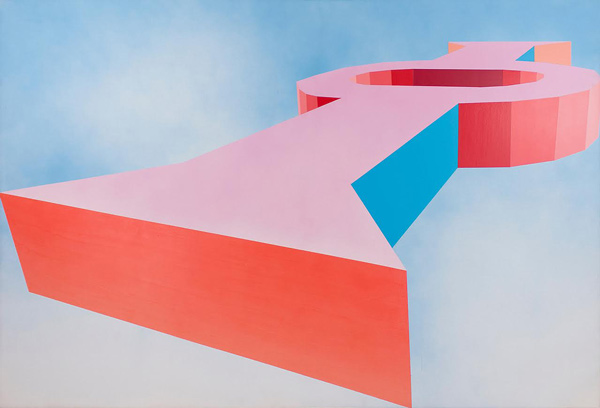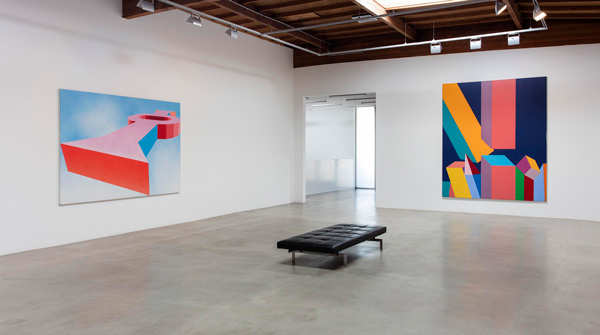Admirers of feminist artist Miriam Schapiro’s (1923-2015) work may be surprised to learn that this influential woman who founded the Feminist Art program at CalArts with artist Judy Chicago and helped organize Womanhouse (1972), an installation project with over 25 women artists in an abandoned Hollywood house, was also working with physicists, early computer technology, and the scientific community to paint large, futuristic portraits of hyper-dimensional, geometric forms in bright, electrified colors.

Byzantium, 1967; acrylic on canvas; 108 x 72 inches; Courtesy of Honor Fraser Gallery, Los Angeles, CA. Photo by Brian Forrest.
One of the earliest paintings in the exhibition, Byzantium (1967), created just after her move to La Jolla, is a pivotal example of Schapiro’s transition from abstract expressionism to Hard Edge painting during this brief period when she lived in Southern California. By comparison, other California Hard Edge painters like Helen Lundeberg (1908-1999) and Lorser Feitelson (1898-1978) focused specifically on achieving flatness and simplicity of shape. Schapiro’s compositions are unrestrained as shapes float freely, in a silent protest to the formal properties of traditional perspective drawing.

Computer Series, 1969; Acrylic and spray-paint on canvas; 49 x 59 inches. Courtesy of Eric Firestone Gallery, Los Angeles, CA..
Computer Series (1969) highlights Schapiro’s embrace of scientific technology as an artmaking tool. Using an early Hewlett Packard computer to plot multiple multiple open cubes, she created an interlocking and elaborate dimensional structure, the background a tangerine orange wash of color. These confounding shapes intentionally obscure the focal point and create a fascinating, mind-bending maze of overlapping lines and picture planes.

Keyhole, 1971; Acrylic and spray-paint on canvas. 71 x 106 inches. Courtesy of Eric Firestone Gallery, Los Angeles, CA.
Keyhole (1971), one of the last paintings from Schapiro’s art and technology period, is perhaps the most overtly feminist. A mysterious shape undulates with bright pink tones as it hovers untethered in a soft blue, spray-painted sky. Schapiro directly confronted the male dominated art world and its masculine symbols by replacing them with new bold, imagined feminist icons.
Schapiro’s bright graphic colors, and her use of experimental computer technology to plot extreme, forced perspectives and angles were so advanced at the time she created these works, they seem refreshingly contemporary and relate more to painting today than to the work of her peers over fifty years ago.
“Miriam Schapiro,” November 4 – December 16, 2017 at Honor Fraser Gallery, 2622 S. La Cienega Blvd. Los Angeles, CA 90034. www.honorfraser.com.


